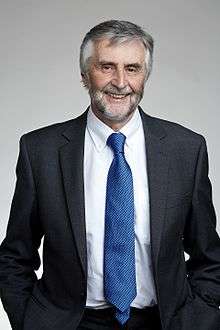Patrick Gill (scientist)
Patrick Gill, MBE, FRS[1] is a Senior NPL Fellow in Time & Frequency at the National Physical Laboratory (NPL) in the UK.[2][3]
| Patrick Gill FRS MBE | |
|---|---|
 Patrick Gill at the Royal Society admissions day in London in 2016 | |
| Alma mater | |
| Employer | |
| Awards |
|
| Website | www |
| Scientific career | |
| Thesis | Charge Transfer as a Laser Excitation Mechanism (1975) |
| Doctoral advisor | Colin Webb |
Education
Gill was educated at the University of Sussex and the University of Oxford where he was awarded a Doctor of Philosophy degree in 1975 for research on Charge Transfer as a Laser Excitation Mechanism.[4]
Research
Gill's research is concerned with laser frequency stabilisation techniques for very high resolution spectroscopy, and the development of leading-edge optical atomic clocks that look to form the basis of a future redefinition of the SI base unit second.[5] These include optical clocks based on laser-cooled single ions confined in radiofrequency traps and neutral atoms held in optical lattices, and which now reach uncertainties below that of the caesium fountain primary frequency standard.[1][6]
Additionally, he has developed a range of stable lasers and optical metrology instrumentation with application to high technology sectors such as precision engineering and manufacture, space science, satellite navigation, Earth observation, defence and security and optical telecommunications.[7][8][9][10]
Awards and honours
Gill is a Fellow of the Institute of Physics (FInstP) and was awarded their Young Medal and Prize in 2008 for world-leading contributions to optical frequency metrology. He also received the I. I. Rabi Award in 2007 from the IEEE International Frequency Control Symposium for contributions to time and frequency metrology and the realisation of single ion optical frequency standards. More recently, his group received the Royal Institute of Navigation's Duke of Edinburgh Award in 2014 for long term atomic clock development.[1] Patrick is a visiting professor at Imperial College London and the University of Oxford. He was awarded an MBE for services to Science in The Queen's 2015 New Year Honours.[11] Gill was elected a Fellow of the Royal Society (FRS) in 2016.[1]
References
- "Professor Patrick Gill MBE FRS". London: Royal Society. Archived from the original on 29 April 2016. One or more of the preceding sentences incorporates text from the royalsociety.org website where:
"All text published under the heading 'Biography' on Fellow profile pages is available under Creative Commons Attribution 4.0 International License." --"Royal Society Terms, conditions and policies". Archived from the original on 25 September 2015. Retrieved 9 March 2016.CS1 maint: unfit url (link)
- "Professor Patrick Gill". Teddington: npl.co.uk. Archived from the original on 7 June 2009.
- Margolis, Helen S. (2004). "Hertz-Level Measurement of the Optical Clock Frequency in a Single 88Sr+ Ion". Science. 306 (5700): 1355–1358. Bibcode:2004Sci...306.1355M. doi:10.1126/science.1105497. PMID 15550666.
- Gill, Patrick (1975). Charge Transfer as a Laser Excitation Mechanism (DPhil thesis). University of Oxford. OCLC 916148756.
- Gill, P. (2011). "When should we change the definition of the second?". Philosophical Transactions of the Royal Society A: Mathematical, Physical and Engineering Sciences. 369 (1953): 4109–4130. Bibcode:2011RSPTA.369.4109G. doi:10.1098/rsta.2011.0237.
- Barwood, G. P.; Gill, P.; Rowley, W. R. C. (1991). "Frequency measurements on optically narrowed Rb-stabilised laser diodes at 780 nm and 795 nm". Applied Physics B Photophysics and Laser Chemistry. 53 (3): 142–147. Bibcode:1991ApPhB..53..142B. doi:10.1007/BF00330229.
- Godun, R. M.; Nisbet-Jones, P. B. R.; Jones, J. M.; King, S. A.; Johnson, L. A. M.; Margolis, H. S.; Szymaniec, K.; Lea, S. N.; Bongs, K.; Gill, P. (2014). "Frequency Ratio of Two Optical Clock Transitions inYb+171and Constraints on the Time Variation of Fundamental Constants". Physical Review Letters. 113 (21): 210801. arXiv:1407.0164. Bibcode:2014PhRvL.113u0801G. doi:10.1103/PhysRevLett.113.210801. PMID 25479482.
- Barwood, G. P.; Huang, G.; Klein, Herbert Arthur; Johnson, L. A. M.; King, S. A.; Margolis, H. S.; Szymaniec, K.; Gill, P. (2014). "Agreement between two88Sr+optical clocks to 4 parts in 1017". Physical Review A. 89 (5). Bibcode:2014PhRvA..89e0501B. doi:10.1103/PhysRevA.89.050501.
- Wilpers, Guido; See, Patrick; Gill, Patrick; Sinclair, Alastair G. (2012). "A monolithic array of three-dimensional ion traps fabricated with conventional semiconductor technology". Nature Nanotechnology. 7 (9): 572–576. Bibcode:2012NatNa...7..572W. doi:10.1038/nnano.2012.126.
- Webster, Stephen; Gill, Patrick (2011). "Force-insensitive optical cavity". Optics Letters. 36 (18): 3572. arXiv:1108.4819. Bibcode:2011OptL...36.3572W. doi:10.1364/OL.36.003572.
- "No. 61092". The London Gazette (Supplement). 31 December 2014. p. N19.